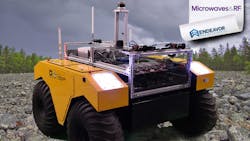Working with research teams at the University of Maryland (UMD), College Park, and UMD, Baltimore County, the U.S. Army is seeking transformational advances in artificial intelligence (AI) through a five-year collaborative effort. A cooperative agreement between the Army and UMD brings together nearly 30 experts in engineering, robotics, computer science, cybersecurity, and other technical disciplines envisioned as essential for future advanced in robotics for warfare. The collaborative research efforts are expected to speed the development of different applications for AI, including in wearable devices and autonomous vehicles (see the figure).
Academic researchers will work with scientists at the U.S. Army Combat Capabilities Development Command (DEVCOM) of the Army Research Laboratory (ARL) on 18 initial projects targeting AI applications. Laurie Locascio, vice-president for research at UMD, said: “It’s a very exciting alliance that leverages the university’s decades-long research partnerships with ARL to forge a critical pipeline for research innovation and commercialization in the booming ecosystem of robotics, AI and autonomy.” The research efforts build on a more than 25-year partnership between UMD and ARL. Through research and modernization, the scientists seek to reduce human risk and workloads during search-and-rescue operations and in harsh environments.
UMD professor Derek Paley, director of the Maryland Robotics Center and lead researcher on the collaborative agreement, said: “This is a big partnership with an ambitious vision: we want to change the world by quickly getting lifesaving autonomy into the hands of the people who need it. No matter how autonomous we think a system is, a human operator will interface with it at some level. The goal is to migrate the dangerous, dirty, and dull work to the autonomous platform.” Co-lead researcher and UMD professor Jeffrey Herrmann added: “This collaboration will plan and develop a consistent modeling and simulation infrastructure that will include libraries of simulation models and tools for building and running them.”
About the Author
Jack Browne
Contributing Editor
Jack Browne, Technical Contributor, has worked in technical publishing for over 30 years. He managed the content and production of three technical journals while at the American Institute of Physics, including Medical Physics and the Journal of Vacuum Science & Technology. He has been a Publisher and Editor for Penton Media, started the firm’s Wireless Symposium & Exhibition trade show in 1993, and currently serves as Technical Contributor for that company's Microwaves & RF magazine. Browne, who holds a BS in Mathematics from City College of New York and BA degrees in English and Philosophy from Fordham University, is a member of the IEEE.
